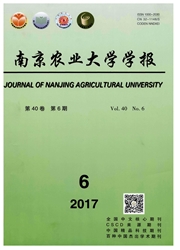

 中文摘要:
中文摘要:
克隆了红树植物‘白骨壤’中甜菜碱/脯氨酸转运蛋白基因(BetlProT2),采用根瘤农杆菌介导的方法,将携带有GFP报告基因的35S—Bet/ProT2-GFP融合质粒转化洋葱表皮细胞,亚细胞定位分析表明,Bet/ProT2是定位在细胞质膜上的跨膜蛋白。进一步利用农杆菌介导法将Bet/ProT2转人粳稻‘日本晴’,鉴定结果表明,BetlProT2基因已经整合到‘日本晴’的基因组中并有效表达。转Bet/ProT2基因水稻的耐盐性明显提高,在甜菜碱和脯氨酸同时或分别存在的条件下,转基因水稻可以在含有150mmol·L^-1NaCl的液体培养基中正常生长,同时叶片中H2O2含量较低;而野生型水稻在相同处理条件下出现明显枯萎,叶片中H2O2大量积累。结论:红树Bet/ProT2基因能通过吸收甜菜碱和/或脯氨酸来降低氧化伤害,显著提高转基因水稻的耐盐能力。
 英文摘要:
英文摘要:
Betaine/proline transporter protein gene ( Bet/ProT2 ) was cloned from Mangrove Avicennia marina. In order to reveal its subeellular localization,35S-Bet/ProT2-GFP fusion plasmid with GFP reporter gene was transferred into onion epidermal cells by Agrobacterium tumefaciens. The results showed that Bet/ProT2 was a trans-membrane protein which was located in the plasma membrane. Bet/ProT2 gene was then transferred into Oryza sativa L.japonica'Nipponbare'by Agrobacterium tumefaciens to study its biological function. PCR results showed that Bet/ProT2 gene was integrated into rice genome and effectively expressed in transgenic plants. The salt tolerance of transgenic rice was improved significantly in the presence of betaine and/or proline in the liquid medium containing 150 mmol· L^-1 NaCl, and the content of H2O2 in the leaves remained at low level under salt stress. Under the same treatment,however, wild-type rice had withered, and massive H2O2 was accumulated in the leaves. These results suggested that Mangrove Bet/ProT2 gene could significantly improve the salt tolerance in the transgenic rice by accumulating compatible solutes and reducing oxidative damage.
 同期刊论文项目
同期刊论文项目
 同项目期刊论文
同项目期刊论文
 Examination of the leaf proteome during flooding stress and the induction of programmed cell death i
Examination of the leaf proteome during flooding stress and the induction of programmed cell death i 期刊信息
期刊信息
